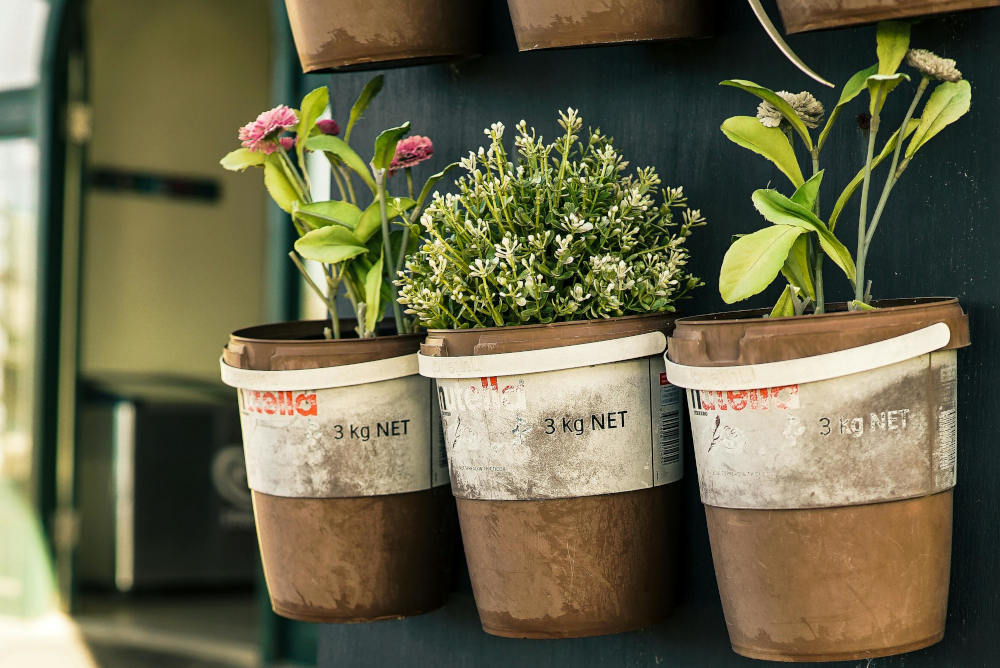
Der Kräuteranbau im Haus ist eine einfache und lohnende Möglichkeit, frischen Geschmack, Duft und Grün in Ihr Zuhause zu bringen. Egal, ob Sie eine sonnige Fensterbank oder eine kleine Wohnungsküche haben, der Kräuteranbau im Haus ermöglicht Ihnen das ganze Jahr über Zugang zu kulinarischen Grundnahrungsmitteln wie Basilikum, Thymian und Petersilie – ganz ohne Garten.
Um mit dem Kräutergarten im Haus erfolgreich zu sein, müssen Sie die spezifischen Bedürfnisse jeder Pflanze kennen. Von Licht und Erde bis hin zu Bewässerung und Ernte – dieser Artikel führt Sie durch alles, was Sie für einen blühenden Kräutergarten im Haus wissen müssen.
Panaprium ist unabhängig und wird vom Leser unterstützt. Wenn Sie über unseren Link etwas kaufen, erhalten wir möglicherweise eine Provision. Wenn Sie können, unterstützen Sie uns bitte monatlich. Die Einrichtung dauert weniger als eine Minute und Sie werden jeden Monat einen großen Beitrag leisten. Danke schön!
Vorteile des Kräuteranbaus im Haus
Bevor wir uns mit dem „Wie“ befassen, wollen wir das „Warum“ untersuchen. Hier sind einige überzeugende Gründe, einen Kräutergarten im Haus anzulegen:
-
Ganzjährige Ernte: Genießen Sie auch im Winter frische Kräuter.
-
Komfort: Schneiden Sie beim Kochen, was Sie brauchen – kein Gang zum Laden.
-
Kostengünstig: Sparen Sie Geld für im Laden gekaufte Kräuter, die oft schnell welken.
-
Gesündere Mahlzeiten: Frische Kräuter verbessern den Geschmack ohne Zusatz von Salz oder Zucker.
-
Luftreinigung: Viele Kräuter helfen, die Raumluft auf natürliche Weise zu reinigen.
-
Ästhetischer Wert: Ein grüner, duftender Kräutergarten erhellt jeden Raum.
Die besten Kräuter für den Indoor-Anbau
Nicht alle Kräuter wachsen im Haus gleich gut. Manche, wie Basilikum und Petersilie, gedeihen auf der Fensterbank, während andere, wie Dill oder Fenchel, aufgrund ihrer Größe oder ihres Lichtbedarfs besser für den Garten im Freien geeignet sind.
Top Indoor-Kräuter:
| Kraut | Warum es in Innenräumen funktioniert |
|---|---|
| Basilikum | Schnellwachsend und hocharomatisch |
| Petersilie | Robust und produktiv bei mittlerem Licht |
| Minze | Wächst gut in Behältern, breitet sich leicht aus |
| Thymian | Kompakt und wartungsarm |
| Schnittlauch | Verträgt weniger Licht und wächst schnell nach |
| Oregano | Gedeiht in Töpfen und bevorzugt trockene Bedingungen |
| Rosmarin | Braucht gutes Licht, ist aber sehr duftend |
| Salbei | Benötigt Sonne, ist aber in Behältern handhabbar |
Schritt 1: Wählen Sie den richtigen Standort
Licht ist der wichtigste Faktor beim Kräuteranbau im Haus. Die meisten Küchenkräuter stammen aus dem Mittelmeerraum und benötigen mindestens 6–8 Stunden direktes Sonnenlicht pro Tag .
Beste Spots:
-
Nach Süden ausgerichtete Fensterbänke (ideal)
-
Nach Osten oder Westen ausgerichtete Fenster (gut mit zusätzlicher Beleuchtung)
-
Unter Wachstumslampen (ideal für Häuser mit wenig Licht)
Wenn du nicht genügend Sonnenlicht hast, investiere in LED-Wachstumslampen , die natürliches Licht imitieren. Platziere sie 15–30 cm über deinen Pflanzen und lasse sie 12–14 Stunden pro Tag eingeschaltet.
🌿 Tipp: Drehen Sie die Töpfe wöchentlich, um ein gleichmäßiges Wachstum auf allen Seiten zu gewährleisten.
Schritt 2: Verwenden Sie die richtigen Behälter
Zimmerkräuter wachsen am besten in Behältern mit guter Drainage . Vermeiden Sie das direkte Einpflanzen in dekorative Töpfe ohne Löcher, da dies zu Wurzelfäule führen kann.
Behältertipps:
-
Material: Terrakotta-, Keramik-, Kunststoff- oder Stofftöpfe eignen sich alle gut.
-
Größe: Beginnen Sie mit 4–6 Zoll großen Töpfen für junge Kräuter. Erweitern Sie die Größe auf 8–10 Zoll für ausgewachsene Pflanzen.
-
Drainage: Stellen Sie sicher, dass jeder Topf Drainagelöcher hat.
🌿 Optional: Stellen Sie unter jeden Topf eine Untertasse, um ablaufendes Wasser aufzufangen und Oberflächen im Innenbereich zu schützen.
Schritt 3: Wählen Sie den richtigen Boden
Gartenerde im Freien ist für den Innenbereich zu dicht. Wählen Sie stattdessen eine leichte, gut durchlässige Blumenerde .
Beste Erde für Zimmerkräuter:
-
Organische Blumenerde für Behälter
-
Mischungen mit der Kennzeichnung „ Gemüse oder Kräuter“
-
Optional Perlite oder Kokosfaser für eine bessere Drainage hinzufügen
Vermeiden Sie feuchtigkeitsspeichernde Mischungen, es sei denn, Sie bauen Kräuter an, die feuchten Boden lieben (wie Minze oder Petersilie).
Schritt 4: Pflanzen Sie Ihre Kräuter
Sie können Kräuter im Haus aus Samen oder Setzlingen ziehen. Beides hat Vor- und Nachteile:
Ausgehend von Samen:
-
Günstiger und bietet mehr Abwechslung
-
Wächst langsamer – die Keimung kann 2–4 Wochen dauern
-
Benötigt gleichmäßige Feuchtigkeit und Wärme (18–24 °C)
Beginnend mit Transplantationen:
-
Schnellere Ergebnisse und einfacher für Anfänger
-
Wird oft in Gartencentern oder Lebensmittelgeschäften verkauft
-
Muss möglicherweise in größere Behälter umgetopft werden
🌿 Tipp: Überfüllen Sie Ihre Töpfe nicht. Eine Pflanze pro Topf ist normalerweise am besten, insbesondere bei großen Kräutern wie Basilikum und Rosmarin.
Schritt 5: Zimmerkräuter gießen
Überwässerung ist die häufigste Ursache für das Versagen von Kräutern im Haus. Die meisten Kräuter trocknen zwischen den Wassergaben leicht aus.
Bewässerungsrichtlinien:
-
Stecken Sie Ihren Finger 2,5 cm tief in die Erde – wenn sie trocken ist, ist es Zeit zu gießen.
-
Gießen Sie an der Basis , nicht auf den Blättern.
-
Leeren Sie die Untertassen nach dem Gießen, um ein Durchnässen der Wurzeln zu verhindern.
Allgemeine Häufigkeit (kann je nach Kraut und Klima variieren):
| Kraut | Bewässerungshäufigkeit |
|---|---|
| Basilikum | Alle 2–3 Tage |
| Petersilie | Alle 3–4 Tage |
| Rosmarin | Einmal pro Woche |
| Minze | Alle 2–3 Tage |
| Thymian | Einmal pro Woche oder seltener |
🌿 Tipp: Besprühen Sie junge Setzlinge oder empfindliche Kräuter wie Koriander mit einer Sprühflasche.
Schritt 6: Füttern und Düngen
Zimmerkräuter brauchen Nährstoffe, aber zu viel Dünger kann zu einem faden Geschmack oder übermäßigem Blattwachstum führen.
Bewährte Methoden:
-
Verwenden Sie einen verdünnten organischen Flüssigdünger (wie Fisch-Emulsion oder Algenextrakt).
-
Während des aktiven Wachstums alle 3–4 Wochen anwenden
-
Verzichten Sie im Winter auf Dünger, wenn die Kräuter ruhen oder langsam wachsen
🌿 Tipp: Manche Kräuter, wie Thymian und Oregano, bevorzugen kargere Böden. Düngen Sie lieber zu wenig.
Schritt 7: Beschneiden und Ernten
Regelmäßiges Beschneiden hält Ihre Kräuter gesund und fördert ein buschigeres Wachstum. Seien Sie nicht schüchtern – Kräuter lieben es, zurückgeschnitten zu werden .
So ernten Sie:
-
Nehmen Sie nie mehr als ein Drittel der Pflanze auf einmal
-
Schneiden Sie Blätter oder Stängel direkt über einem Blattknoten ab, um die Verzweigung zu fördern
-
Bei Kräutern wie Basilikum kneifen Sie die Blütenknospen ab , um die Blattproduktion zu verlängern
🌿 Tipp: Ernten Sie morgens, wenn die Öle am konzentriertesten sind, um das beste Aroma zu erhalten.
Häufige Probleme beim Kräuteranbau in Innenräumen (und Lösungen)
| Problem | Ursache | Lösung |
|---|---|---|
| Vergilbende Blätter | Überwässerung oder schlechte Drainage | Erde trocknen lassen, Topfentwässerung prüfen |
| Langbeinige, schwache Stängel | Nicht genug Licht | Stellen Sie das Gerät an einen helleren Ort oder fügen Sie Wachstumslampen hinzu |
| Welken auch nach dem Gießen | Wurzelfäule oder verdichteter Boden | Umtopfen mit frischer, gut durchlässiger Mischung |
| Schädlinge (Blattläuse, Spinnmilben) | Trockene Raumluft, schwache Pflanzen | Regelmäßig besprühen, Blätter mit Neemöl abwischen |
| Schwaches Wachstum | Mangel an Nährstoffen oder Wurzelraum | Leicht düngen, bei Bedarf umtopfen |
Gestaltungsideen für Kräutergärten im Innenbereich
Der Kräuteranbau im Haus muss nicht zwangsläufig zu überfüllten Arbeitsflächen führen. Mit ein wenig Kreativität kann Ihr Kräutergarten ein schöner Teil Ihres Zuhauses sein.
Kreative Ideen für Kräutergärten:
-
Kräutergarten im Einmachglas: Stilvoll und kompakt (achten Sie auf ausreichende Drainage).
-
Hängende Pflanzgefäße: Ideal für sonnige Küchenfenster.
-
An der Wand montierte Kräuterregale: Verwenden Sie gestufte Regale oder hängende Töpfe.
-
Hydroponische Systeme: Hochtechnologische, erdlose Systeme für pflegeleichten Anbau.
-
Vertikale Gartentürme: Stapelbare Pflanzgefäße, die den Platz optimal nutzen.
🌿 Tipp: Beschriften Sie Ihre Kräuter mit selbstgemachten Etiketten für eine hübsche und praktische Note.
Die besten Begleitkräuter für den gemeinsamen Anbau im Innenbereich
Wenn Sie wenig Platz haben, können Sie bestimmte Kräuter zusammen in einen großen Topf pflanzen. Achten Sie nur darauf, dass sie ähnliche Licht- und Wasserbedürfnisse haben.
Gute Kräuterkombinationen:
-
Basilikum + Petersilie + Schnittlauch – Liebt Feuchtigkeit und regelmäßiges Beschneiden
-
Thymian + Oregano + Rosmarin – Bevorzugt trockenen Boden und volle Sonne
-
Minze + Zitronenmelisse – Beide wachsen aggressiv; in einen großen Behälter pflanzen
Was Sie vermeiden sollten:
-
Minze mit anderen Kräutern – sie verbreitet sich schnell und wird sich durchsetzen
-
Kombination von feuchtigkeitsliebenden Kräutern mit Kräutern für trockene Böden
Wintertipps für Zimmerkräuter
Kräuter im Haus können das ganze Jahr über wachsen, aber der Winter bringt Herausforderungen mit sich:
-
Trockene Luft: Verwenden Sie eine Feuchtigkeitsschale oder einen Luftbefeuchter, um das Austrocknen der Blätter zu verhindern.
-
Schwaches Licht: Ergänzen Sie die Beleuchtung 12–14 Stunden am Tag mit Wachstumslampen.
-
Kühle Zugluft: Halten Sie Kräuter von Fenstern fern, durch die kalte Luft dringt.
🌿 Tipp: Der Winter eignet sich hervorragend für den Anbau langsam wachsender Kräuter wie Rosmarin oder Lorbeer.
Abschließende Gedanken
Der Kräuteranbau im Haus ist praktisch und lohnend. Mit dem richtigen Licht, den richtigen Behältern, der richtigen Erde und der richtigen Pflege können Sie das ganze Jahr über frische, aromatische Kräuter auf Ihrer Fensterbank oder Arbeitsplatte züchten.
Egal, ob Sie italienische Pasta mit frischem Basilikum kochen oder einen Cocktail mit selbst angebauter Minze garnieren, es gibt nichts Schöneres, als Kräuter direkt aus Ihrem eigenen Indoor-Garten zu schneiden.
War dieser Artikel hilfreich für Sie? Bitte teilen Sie uns in den Kommentaren unten mit, was Ihnen gefallen oder nicht gefallen hat.
About the Author: Alex Assoune
Wogegen Wir Kämpfen
Weltweit-Konzerne produzieren in den ärmsten Ländern im Übermaß billige Produkte.
Fabriken mit Sweatshop-ähnlichen Bedingungen, die die Arbeiter unterbezahlt.
Medienkonglomerate, die unethische, nicht nachhaltige Produkte bewerben.
Schlechte Akteure fördern durch unbewusstes Verhalten den übermäßigen Konsum.
- - - -
Zum Glück haben wir unsere Unterstützer, darunter auch Sie.
Panaprium wird von Lesern wie Ihnen finanziert, die sich unserer Mission anschließen möchten, die Welt völlig umweltfreundlich zu gestalten.
Wenn Sie können, unterstützen Sie uns bitte monatlich. Die Einrichtung dauert weniger als eine Minute und Sie werden jeden Monat einen großen Beitrag leisten. Danke schön.































0 Kommentare